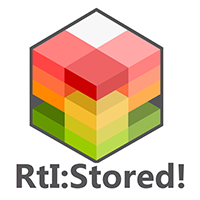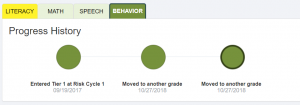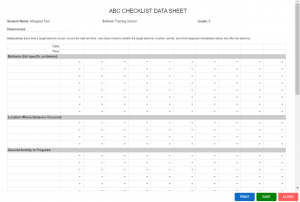I. – Getting Started
II. – Tier One Plans
III. – Early Warning System
IV. – Moving Between Tiers
VI. - SEL
VII. – 504 Plans
Appendix A. – Guided Plans
Appendix B. – Support Documents
Appendix C. – Video Support
Appendix D. - Frequently Asked Questions
- FAQs
Appendix E. – MTSS Glossary of Terms
Behavior Supports
Setting District Behavior Tier 1 Expectations
The school-wide Tier 1: Differentiated Core Instruction Plan is entered one time and automatically populates specified grade levels.
School-wide plans should be written by a designated team and entered by someone with building-level access. Often these plans are entered by the school counselor.
Create Tier 1 Behavior Plan
For additional support, see sample SEL plan in the Guided Tiered Plans section of this Success Guide.
Analyze the Data
As with the Tier 1 Academic Plan, you will begin with data analysis.
This section can be customized by schools to allow grade or departments teams to enter their numerical data. For example, you should create a template in which grade level teams can enter data from their grade level SEL screener.
PLC Instructional Expectations
Instruction: click on the drop down arrow and choose from the preset expectations that were set in the Behavior Tier 1 Expectations section
Curriculum: click on the drop down arrow and choose from the preset expectations that were set in the Behavior Tier 1 Expectations section
Environment: click on the drop down arrow and choose from the preset expectations that were set in the Behavior Tier 1 Expectations section
Core Best Practices
![]()
Note: This is an optional feature for schools who do not have a strategic School-wide Behavior Plan or Matrix established.
A bank of research based best practices for delivering instruction effectively for behavior
Develop and Implement Action Plan
- Who: Set this section as a template for each grade level/department to enter during their PLC meeting.
- What: List the established school-wide expectations.
- Where: All settings should be typed into this section.
- How Often: see suggested teaching of behaviors below:
Data Evaluation
Baseline Data: This is the data stated in the Analyze the Data section
Short Term Goal: A goal for Middle of Year (MOY) should be set for percentage of students who …
Long Term Goal: A goal for End of Year (EOY) should be set for percentage of students …
Measurement Strategy
- Who: set this section as a template for each individual grade level/department to enter during their PLC meeting
- With What: List the data that is/will be analyzed
- How Often: 2-3 times per year
The next section is not completed until the PLC team reviews data following the next universal screening/universal assessment window and makes a data-driven decision for overall grade/department.
Click “SAVE” at the bottom of the Tier 1 SEL Plan.
Notes:
- PLC teams will see this completed template when they click on EDIT next to Behavior in the PLC link for creating/viewing their Tier 1: Differentiated Core Instruction Plans
- PLC teams will enter in their specific Grade/Department and the data specific to their Grade/Department in the template for the following sections
Completing Tier 1 Behavior Plan
additional support, see sample behavior plan in the Guided Tiered Plans section of this Success Guide.
Analyze the Data
As with the Tier 1 Academic Plan, you will be with data analysis.
- This section can be customized by schools to allow grade or departments teams to enter their numerical data. For example:
For the _(prior year)_ school year, the _(grade level/department)_ team had a total of __ ODR’s (__% of total school-wide ODR’s), __ ISS days (__% of total school-wide ISS days), __ OSS days (__% of total school-wide OSS days), __ Bus Incidences (__% of total school-wide bus incidences).
PLC Expectations
Instruction: click on the drop down arrow and choose from the preset expectations that were set in the Behavior Tier 1 Expectations section
Curriculum: click on the drop down arrow and choose from the preset expectations that were set in the Behavior Tier 1 Expectations section
Environment: click on the drop down arrow and choose from the preset expectations that were set in the Behavior Tier 1 Expectations section
Core Best Practices
![]()
Note: This is an optional feature for schools who do not have a strategic School-wide Behavior Plan or Matrix established.
A bank of research based best practices for delivering instruction effectively for behavior
Develop and Implement Action Plan
Who: Set this section as a template for each grade level/department to enter during their PLC meeting.
What: List the established school-wide expectations.
Where: All settings should be typed into this section.
How Often: see suggested teaching of behaviors below:
Data Evaluation
- Baseline Data: This is the data stated in the Analyze the Data section
- Short Term Goal: A goal for Middle of Year (MOY) should be set for percentage of students who receive ODR; ISS; OSS; Bus Incidences; etc. – and should be attainable and based on the baseline data
- Long Term Goal: A goal for End of Year (EOY) should be set for percentage of students who receive ODR; ISS; OSS; Bus Incidences; etc. – and should be attainable and based on the baseline data and MOY data
Measurement Strategy
Who: set this section as a template for each individual grade level/department to enter during their PLC meeting
With What: List the data that is/will be analyzed
How Often: 2-3 times per year
The next section is not completed until the PLC team reviews data following the next universal screening/universal assessment window and makes a data-driven decision for overall grade/department.
Click “SAVE” at the bottom of the Tier 1 Behavior Plan.
Notes:
- PLC teams will see this completed template when they click on EDIT next to Behavior in the PLC link for creating/viewing their Tier 1: Differentiated Core Instruction Plans
- PLC teams will enter in their specific Grade/Department and the data specific to their Grade/Department in the template for the following sections:
Analyze the Data
Develop and Implement Action Plan
Measurement Strategy
- Refer to the Tier 1: Differentiated Core Instruction Plans section of this Success Guide for support completing these plans.
Moving a Student to Tier 1 At-Risk
Follow the step-by-step directions in the Moving Between Tiers section of this Success Guide.
Classroom Management Checklist
Determine effectiveness of the classroom management system to determine if behavior concerns are related to the student or environmental concerns.

Moving a Student to Tier 2
Students must be identified as Tier 1 At-Risk for behavior before being moved to Tier 2.
In the student’s file, click the yellow “Move Student to Tier 2 For Next Cycle” button:
You will be prompted to select Internalizing Behaviors or Externalizing Behaviors:
Internalizing Behaviors: The only person who can view/edit the documents will be the school counselor.
This is due to confidentiality laws/rules.
It will be apparent that the student is in Tier 2 (or Tier 3) for behavior, however the Review Document Checklist items will only be accessible to the counselor.
The system will prompt other users to see the counselor for more information.
Externalizing Behaviors: This option functions like academic areas and may be viewed/edited by any teacher that works with that student, as well as users with building-level access.
Behavior Tier 2
Observations are required to move a student to Tier 2 for behavior concerns.
These include:
- Frequency Charts
- ABC Charts (Antecedent/Behavior/Consequence)
Use the data collected to complete a Functional Behavior Analysis.
This information helps establish the function of the student’s unwanted behavior – which is imperative to designing an individual behavior plan.
See the following templates below:
- Competing Pathways (see below)
- Functional Behavior Analysis Template
Behavior Progress Monitoring
Collect data to determine if unwanted behavior is decreasing and wanted behavior is increasing.
Track interval behavior data of a student based on desired behavior, alternative behavior, and problem behavior to determine effectiveness of the intervention being implemented

Moving a Student to Tier 3
Behavior Intervention Plan (BIP) – A Behavior Intervention Plan is completed if an individual student is in need of more intensive supports through an individualized behavio plan.
You must first complete “Review Document Checklist” items set by your district.
Competing Pathways
NOTE: This is the plan that you will see after a student enters Behavior Tier 2. This plan is different than Tier 2 academic student plans.


Notes:
See Moving Between the Tiers section for how to:
Upload documents
Complete online documents
Add additional documents






